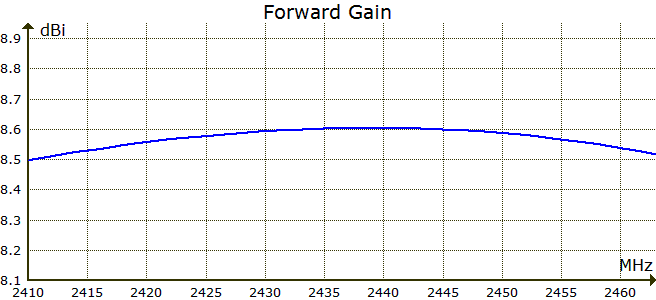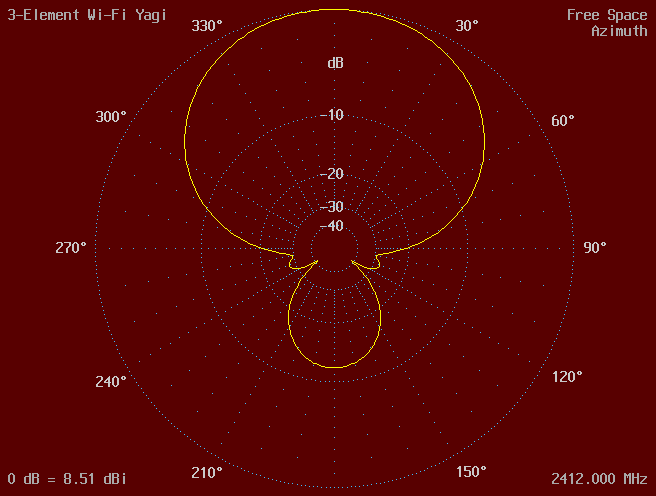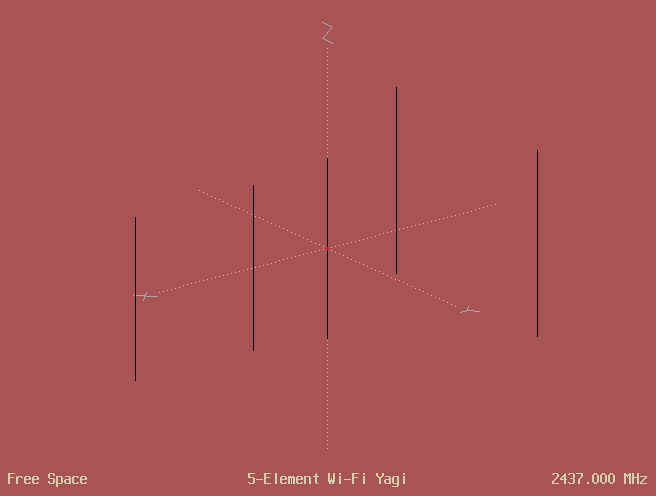It's easy to make a small Yagi for a wireless router even if it lacks an antenna connector. The photo shows how I added two parasitic elements to the sleeve dipole of my Netgear WGR614.

With the AO 8.51 Antenna Optimizer I modeled a three-element Yagi at 2412, 2437, and 2462 MHz. These are center frequencies of the lowest, middle, and highest U.S. Wi-Fi channels. To model the sleeve dipole, I optimized the length of an isolated driven element for minimum SWR. Then I added the parasitics and optimized their lengths and positions for maximum forward gain, including mismatch loss for a 50Ω source impedance. All optimizations weighted the three frequencies equally. Finally, I rounded the dimensions. Below are calculated performance figures at the channel centers using 30 analysis segments per halfwave. Forward gain includes mismatch and conductor losses.
Channel Frequency Impedance SWR Mismatch Conductor Forward F/B
MHz ohms Loss dB Loss dB Gain dBi dB
1 2412 35.7 + j0.2 1.40 0.12 0.01 8.48 11.98
2 2417 35.7 + j2.0 1.41 0.13 0.02 8.51 11.85
3 2422 35.7 + j3.9 1.42 0.13 0.02 8.54 11.72
4 2427 35.7 + j5.7 1.44 0.14 0.02 8.57 11.56
5 2432 35.8 + j7.7 1.46 0.16 0.02 8.59 11.40
6 2437 35.8 + j9.7 1.50 0.17 0.02 8.60 11.22
7 2442 35.9 + j11.7 1.54 0.20 0.02 8.61 11.04
8 2447 36.0 + j13.8 1.58 0.23 0.02 8.61 10.84
9 2452 36.1 + j15.9 1.63 0.26 0.02 8.60 10.64
10 2457 36.3 + j18.1 1.69 0.30 0.02 8.59 10.43
11 2462 36.4 + j20.3 1.76 0.34 0.02 8.57 10.21


The broad forward lobe makes aiming noncritical. The antenna in the photo is aimed to the right.
Construction
I cut a piece of plastic from a yogurt container top to support the parasitic elements. I folded the plastic and cut slits for the sleeve dipole. Then I drilled holes for the elements, which are made of

The signal to my wireless adapter card dropped 6 dB when I removed the parasitics from the router dipole. The Yagi provides a fourfold increase in power, which will double the operating range. When signal strength is the limiting factor, it will quadruple throughput.
Antenna File
3-Element Wi-Fi Yagi Free Space 2412 2437 2462 MHz 3 copper wires, inches diam = #14 ref = 1.125 dir = 1 rp = -1.5625 dp = .9375 1 rp 0 -ref rp 0 ref diam 1 0 0 -1.085 0 0 1.085 #14 1 dp 0 -dir dp 0 dir diam 1 source Wire 2, center
Sensitivity Analysis
The following table shows the change in average performance over 2412, 2437, and 2462 MHz in dB when altering a single dimension by 1⁄32″ (1⁄64″ for ref and dir, which represent element half-length, and 25% for diam).
Symbol Gain F/B
diam 0.13 0.92
ref 0.04 0.38
dir 0.09 1.34
rp 0.01 0.17
dp 0.04 0.62
Larger Yagi

I optimized a five-element Yagi that maintains mechanical balance with two offset reflectors. Forward gain is 2.5 dB greater than for the three-element design. This should increase range 36% or throughput 78%. These improvements may not be worth the additional complexity.
Antenna file:
5-Element Wi-Fi Yagi Free Space 2412 2437 2462 MHz 5 copper wires, inches diam = #14 ref = 1.125 d1 = 1 d2 = .9875 s = 1.3125 rp = -2 d1p = 1.06125 d2p = 2.75 1 rp -s -ref rp -s ref diam 1 rp s -ref rp s ref diam 1 0 0 -1.085 0 0 1.085 #14 1 d1p 0 -d1 d1p 0 d1 diam 1 d2p 0 -d2 d2p 0 d2 diam 1 source Wire 3, center
Sensitivity analysis:
Symbol Gain F/B
diam 0.30 4.20
ref 0.03 1.77
d1 0.06 3.87
d2 0.04 1.43
s 0.01 0.67
rp 0.00 0.57
d1p 0.04 0.39
d2p 0.03 1.19
April 27, 2014
 88–108 MHz
88–108 MHz